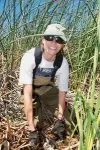(Press-News.org) As sea levels rise due to global warming, ecosystems are being altered. One small silver lining, scientists believed, was that the tidal wetlands found in estuaries might produce less methane – a potent greenhouse gas – as the increasing influx of seawater makes these habitats less hospitable to methane-producing microbes.
However, research from biologists at Lawrence Berkeley National Laboratory (Berkeley Lab) and UC Berkeley indicates that these assumptions aren’t always true. After examining the microbial, chemical, and geological features of 11 wetland zones, the team found that a wetland region exposed to a slight amount of seawater was emitting surprisingly high levels of methane – far more than any of the freshwater sites.
Their results, now published in mSystems, indicate that the factors governing how much greenhouse gas is stored or emitted in natural landscapes are more complex and difficult to predict than we thought.
“We looked at how many methanogens, the organisms that make methane, are present in soils at these sites and it wasn't really well correlated with the amount of methane observed,” said senior author Susannah Tringe, director of Berkeley Lab’s Environmental Genomics & Systems Biology Division. “And even if you look at the amount of methanotrophs, organisms that eat methane, in combination with methanogens, that doesn’t seem to fully explain it.”
Tringe and her colleagues took soil samples from the 11 sites and used high-throughput sequencing to analyze DNA from organisms found in the samples, including bacteria, viruses, and fungi. They examined what genes were present in the sequences and mapped them to known functions – for example, identifying genes known to be involved in metabolizing nitrogen or genes from bacteria that use sulfate during respiration. Then they worked to model how the genetic information they found, combined with chemical factors in the soil and water, could result in the methane emissions they observed.
Across most of the sites, which ranged from freshwater to full seawater salinities, the amount of methane emitted was inversely related to the amount of salt water that was flowing in and mingling with the river water. But at one site, which had been restored in 2010 from a seasonal grassy pasture for livestock grazing back to its original wetland habitat, the team saw high methane emissions despite the moderate amount of salt water.
Seawater contains more sulfate (an ion with sulfur and oxygen) than freshwater, leading to the assumption that increased influx of seawater in these environments would lead to less methane production as the methanogens that use CO2 to make cellular energy are outcompeted by the bacteria that use sulfate instead.
“Ultimately, we found that there were significant influences from other bacterial groups like the ones that break down carbon and even organisms that are better known as nitrogen cyclers, and we couldn’t readily explain the methane emissions by something as simple as, for example, how much sulfate is available or how many methanogens are there,” said Tringe.
Another concept in ecology is that restoring habitats to their native state can boost carbon storage, improve water quality, and increase wildlife populations. In recent decades, wetlands have been increasingly recognized as critical ecosystems for these environmental services, leading to widespread efforts to restore ecosystems by removing barriers, pollution, and non-native organisms.
Modeling work by co-author Dennis D. Baldocchi, Executive Associate Dean and professor of Biometeorology at UC Berkeley, suggests that although the restored wetland is adding greenhouse gas to the atmosphere currently, the ecosystem will stabilize and begin to serve as a net carbon sink within 100 to 150 years. This may not be the timeline that stakeholders were hoping for when they restored the area with the goal of carbon sequestration.
“We want to know if these systems will act as long-term carbon sinks,” said Baldocchi. “And these microbiological investigations can help refine our models and predictions.”
Tringe noted that other labs have observed increased methane production from wetland soils with increased salinity. Scientists from Duke University took soil core samples from a coastal freshwater wetland and exposed them to artificial seawater, and artificial seawater lacking sulfate. In both cases, methane production went up. Tringe’s lab recently collaborated with Marcelo Ardón of North Carolina State University to analyze the microbial communities in those soils.
“There was this expectation that sulfate would be the most important thing. And in those studies, not only did salt water stimulate methane production, which again is kind of counter to the dogma that sulfate is important, it happened whether you had sulfate there or not; in fact the sulfate didn't have a big effect on the methane emissions,” said Tringe. “So I think these experimental manipulations are reconfirming the story that there's more nuanced effects of seawater intrusion than just a sulfate addition, and also more nuanced factors behind ecosystem restoration.”
This work was supported by the Department of Energy (DOE) Early Career Research Program award to Tringe and the DOE Joint Genome Institute.
# # #
Lawrence Berkeley National Laboratory (Berkeley Lab) is committed to delivering solutions for humankind through research in clean energy, a healthy planet, and discovery science. Founded in 1931 on the belief that the biggest problems are best addressed by teams, Berkeley Lab and its scientists have been recognized with 16 Nobel Prizes. Researchers from around the world rely on the Lab’s world-class scientific facilities for their own pioneering research. Berkeley Lab is a multiprogram national laboratory managed by the University of California for the U.S. Department of Energy’s Office of Science.
DOE’s Office of Science is the single largest supporter of basic research in the physical sciences in the United States, and is working to address some of the most pressing challenges of our time. For more information, please visit energy.gov/science.
END
A new qualitative study highlights the negative interpersonal and psychological consequences associated with “yo-yo dieting,” also known as weight cycling. The work underscores how toxic yo-yo dieting can be and how difficult it can be for people to break the cycle.
“Yo-yo dieting – unintentionally gaining weight and dieting to lose weight only to gain it back and restart the cycle – is a prevalent part of American culture, with fad diets and lose-weight-quick plans or drugs normalized as people pursue beauty ...
Star-shredding black holes are everywhere in the sky if you just know how to look for them. That’s one message from a new study by MIT scientists, appearing today in the Astrophysical Journal.
The study’s authors are reporting the discovery of 18 new tidal disruption events (TDEs) — extreme instances when a nearby star is tidally drawn into a black hole and ripped to shreds. As the black hole feasts, it gives off an enormous burst of energy across the electromagnetic spectrum.
Astronomers have detected previous tidal disruption events by looking for characteristic bursts in the optical and X-ray bands. To date, these searches have ...
January is a time when many people are looking for new diet routines, and intermittent fasting is trending, as are traditional calorie cutting programs.
Research conducted with animal models suggests that intermittent fasting slows aging, and those animals live longer. Researchers at the Pennington Biomedical Research Center and the University of Alabama at Birmingham are conducting the DiAL-Health study to see if eating for 8 hours and fasting for 16 each day shows similar results in people. These researchers ...
Like it or not, social media has become the new mall for kids. It’s where they want to be, and it’s a place they can easily go—often with no guidance, no oversight, and no guardrails. And when the content gets ugly or confusing or weird, it can be tough for them to know what to do.
Dominic DiFranzo, an assistant professor of computer science and engineering in Lehigh University’s P.C. Rossin College of Engineering and Applied Science, has devoted his research to helping kids better navigate the perils of social media. He and his team have recently received two grants from the National Science Foundation to develop artificial intelligence tools ...
Vijay Shah, Assistant Professor, Cybersecurity Engineering, received funding for the project: "Fingerprinting Technology for Enhancing 5G/NextG O-RAN Supply Chain Risk Management."
In this project, Shah is focusing on distinctive power signatures and electromagnetic emanations to fortify supply chain risk management of 5G/Next G networks.
This technology has the potential to create a robust framework for comprehensive validation and testing across the entire lifespan of deployed Open Radio Access Network (O-RAN) systems. This, in turn, could ...
'Millennials don't really want to work. They're far too focused on avocado toast and chai lattes!' Just one of the many clichés expressed by workers over the age of fifty. And those being criticized? Well, they often reply with a bored 'OK, Boomer' followed by an eye roll and some ironic remark about the excessively performance-driven worldview of those born between the mid 1950s and the mid 1960s. Work, it seems, just isn't as important to the young as it is to older generations. But it's not just about baby boomers and millennials. Parked between them is Generation X, ...
Calcium ions are essential for cells, but can be toxic in higher concentrations. A team of researchers has now designed and prepared a combination drug that kills tumor cells by modulating the calcium influx into the cell. An external calcium source is not necessary because only the calcium ions already present in the tumor tissue are used, according to the study published in the journal Angewandte Chemie.
Biological cells need calcium ions, among other things, for the proper functioning of the mitochondria, the powerhouses of the cells. However, ...
A University of Houston optometry researcher is warning against the use of low-level red light (LLRL) therapy as a method to control myopia, or nearsightedness, especially in children. Over the last few years, LLRL has emerged as a viable myopia treatment after studies reported the treatment as effective and responsible for significant reduction in myopia progression. The company behind one of the devices reports that it is already being used to address myopia in over 100,000 pediatric patients.
But the excitement over its results as a myopia treatment may have come too soon, ahead of its proven safety.
"Based on measurements in our laboratory, ...
WASHINGTON, Jan. 29, 2024 — Counterfeit detector pens use a starch-iodine reaction to identify fake bills. But could you fool them with chemistry? In today’s episode, we dive into the chemistry of iodine, its color and its clock reactions, all while making a little extra cash on the side. https://www.youtube.com/watch?v=xDaVCyOBSsY
Reactions is a video series produced by the American Chemical Society and PBS Digital Studios. Subscribe to Reactions at http://bit.ly/ACSReactions and follow us on Twitter @ACSReactions.
The American Chemical Society (ACS) is a nonprofit organization chartered by the U.S. Congress. ACS’ mission is to advance the broader ...
Humans and our closest relatives, living apes, display a remarkable diversity of types of locomotion—from walking upright on two legs to climbing in trees and walking using all four limbs.
While scientists have long been intrigued by the question of how humans’ bipedal stance and movement evolved from a quadrupedal ancestor, neither past studies nor fossil records have permitted the reconstruction of a clear and definitive history of the early evolutionary stages that led to human bipedalism.
However, a new study, which centers on recently discovered evidence from skulls of a 6-million-year-old fossil ape, Lufengpithecus, ...








